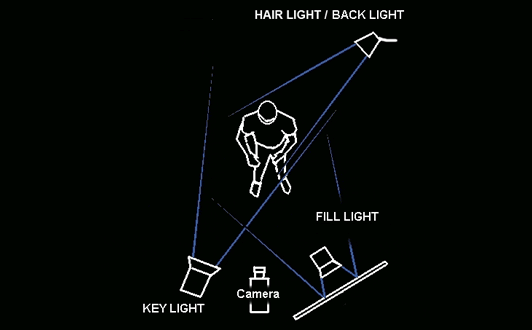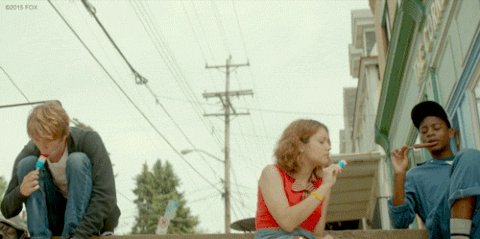technical.
When it comes to shows, short films, movies, and any production, there are a few things that you need to keep in mind; Lightings, Sound, Editing, Scripting, Cinematography, and how you’re going to use it to build a script and a scene. Here are some useful terminology that are useful when it comes to building a scene.
Lighting
-
Natural: Ambient light. It’s basically the type of lighting that is used when you shoot outside in the daytime. It gives a very natural look to a scene.
-
Three point: Standard lighting in film and photography. Includes Key light, Fill light, and back light.
-
Key lighting: The first and the MOST IMPORTANT light, considering the fact that it's the single most important light in the filmography, and the main source.
-
Fill lighting: Secondary light, used to fill the shadows that the key lighting may make. put at the opposite of the key light.
-
Back lighting: Third light, used to create definition and make the subject in the scene stand out.
-
Chiaroscuro: A type of lighting which shows great contrasts between the darkness and light. Usually lacks colour.
-
Spotlighting: A light which is put on a specific spot, to emphasise a specific object or person in the shot.
-
White lights: Colourless lights, eg. ambient lights
-
Warm lights: Lights with warm colours in them (red-orange-brown-yellow), used to create certain moods and feelings, and times of the day.
-
Cold light: Lights with cold colours in them (green-blue-purple-pink) used to create certain moods and feelings, and times of the day.




Sound
-
Diegetic: Sounds to use to set a scene, eg background noise. Usually sourced from the place where the sound is set.
-
Ambient: The natural sound that fits the setting the scene is in.
-
Non Diegetic: Sounds that aren't used to set a scene, like background music, and narration.
-
Foley sound- Creating sound effects after you film, most useful for fighting sounds, to create hitting sounds without getting the actors to actually hit each other.
-
Sound effects: a sound that has been made prior to filming, to emphasise certain things in a scene.
-
Sound bridges: Sounds that carry over with a change in transition.
Editing
-
Editor’s cut: A cut of a film created by the editor alone.
-
Director’s cut: A cut of a film that is created in the director's image
-
final cut: The very final cut, the cut that is used as the final movie.
-
Colour: How you light and colour certain scenes. Helps to create a certain move and meaning within shots, can help enhance certain points and effects. Basic and Powerful.
-
Montage: A series of shots put together, usually to music or a voiceover, to show a passage in time.
-
Jump-cuts: A quick, abrupt transition from one scene to another.

Cinematography
-
Proxemics: How close or far an actor, or object is from the camera, Where we place stuff in the frame to set a scene.
-
Contrasts: in film, based on where you look in the frame. Dominant Contrast is where you look first, and the subsidiary contrast is what you notice next, can be manipulated via size, lights and colour.
-
Mise-en-scene: Where you put everything in the frame to express meaning. This includes set, location, props, costume, hair, makeup, colour, performance, lighting, facial expression, body language
-
Forms: How characters are within the frame.
-
Open form- Characters walk in, out and around the frame
-
Closed form- Characters are set in a frame



Building a Script

Slugline
Scene Direction
Character name
Dialogue
Action
Parenthesis
Slugline: A Scene heading. Placed at the top of each scene, sets place and time.
Scene Direction: Describes the scene in detail, explains how the scene should be, and what the actors do. Always written in the present tense,
Character name: The name of the character. Placed in front of Dialogue, used to show who is talking.
Dialogue: Speech. What the character is saying.
Parenthesis: Actors direction, usually tells them how to say/do certain things in the script. Always in brackets.
Building a scene
-
Moving the story forward: How the story progresses from one scene to another. This is important because smoother and natural transitions will create a more relatable and better final product.
-
Showing VS telling: It’s basically the idea of showing a certain thing, rather than telling the audience a certain thing. With still shots, it’s basically Bruce Wayne, as a child, staring at two graves with the rain pouring down on him, vs, him sitting down and being like “man oh man, I can’t believe my parents have died.”
You are a fool, if you can’t tell which one is more effective, but if you can’t; while you can tell things if the story calls for it, showing can give the audience the same info without having to sacrifice the story.
-
Pacing: Pacing is how quickly or slowly you move from one plot point to another. This is EXTREMELY important, because the pacing of each scene, and thus, your final product, can heavily affect how good or bad your scene is.
-
Mood: Mood is basically how you set the mood in a certain scene. Lighting, colour, sound, and the character can all factor into this.
-
Conflict: Most stories have conflict. Unless you are making a slice of life, or a short film that has no substance, then your story must have conflict. The conflict helps put something at stake for your characters, which pushes the story along to it’s climax.


